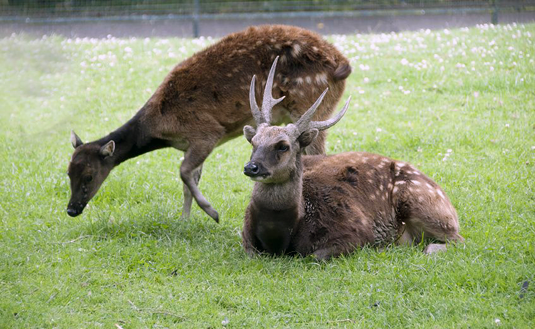Ancient DNA reveals novel relationships
LMU researchers have sequenced mitochondrial DNA from museum specimens of rare species of deer. Analysis of partial nucleotide sequences has enabled the team to refine our picture of the evolutionary history of cervids.
08.08.2016

Philippine spotted deer (Source: d40xboy /fotolia.com)
Deer (Cervidae) inhabit nearly all continents, and as ruminant artiodactyls they are closely related to our modern species of domesticated livestock. However, in spite of much work, the phylogeny of cervids has not yet been fully elucidated. In order to reconstruct the evolutionary history of the group and clarify the relationships between its members, molecular phylogenetic data are essential. Researchers Nicola Heckeberg, Gertrud Rössner and colleagues at the Department of Earth and Environmental Sciences at LMU and the Bavarian State Collection for Palaeontology and Geology) have now partially sequenced mitochondrial DNA samples from museum specimens of five deer species for which molecular data were not previously available. “This work also contributes to conservation,” says Heckeberg. “Only if we are able to delimit species, we can assess whether or not that species is endangered.” The researchers report their new findings in the online journal PeerJ.
“Molecular data were already available for 46 of the 55 living cervid species ,” says Heckeberg. “Our aim was to complement this dataset and place the newly sequenced species in the cervid family tree.” Since the species involved are already rare and difficult to sample in the wild, the researchers resorted to material from a total of 13 museum specimens – and extracted DNA from samples of bone, skin and the dried remains of soft tissues. Some of these specimens were more than 100 years old and thus, the DNA was degraded. Nevertheless, the researchers succeeded in sequencing fragments of this ancient DNA corresponding to part of the genome of the mitochondria (the organelles responsible for the synthesis of ATP, which powers chemical reactions in nucleated cells).
By this means, Heckeberg was able to confirm that a second form of muntjac (Muntiacus atherodes) found in Borneo (together with M. muntjac) is a bona fide species, while the Philippine spotted deer (Rusa alfredi) appears to represent a subspecies of the Philippine brown deer (R. marianna). The two genera of New World deer , Mazama and Pudu, were found to be polyphyletic, which was already known for Mazama, but has been shown for the first time in Pudu. Thus, the morphological similarities that led to their classification into the same clade are not the result of descending from a common ancestor, but reflect adaptations to related environments (convergent evolution). The new sequence data have been deposited in public databases, and are freely available for use by other researchers in further studies of cervid phylogeny.
PeerJ 2016





